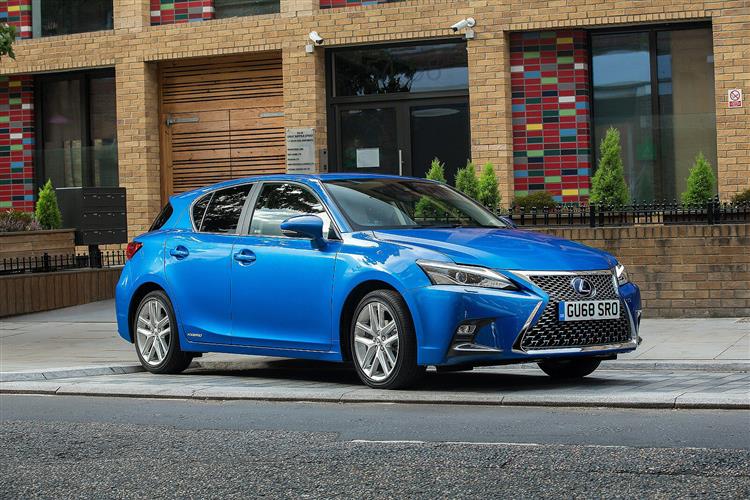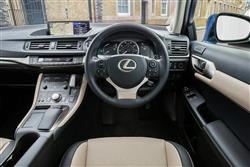MORE OF A C-CHANGE (some text hidden) --NONE--
By Jonathan Crouch
Introductionword count: 111
If you're seeking a spaciously compact, prestigiously-badged premium five-door hatchback from the 2017-2020 period, then you're probably thinking diesel power and German badgework. Here's a different way to go, this improved late-production version of Lexus's CT200h petrol/electric hybrid, announced for the 2018 model year to prolong this design's life in our market. Earlier versions of this car needed a little perfecting but in this form, it became a surprisingly credible choice for those who saw overall running costs and exemplary refinement amongst their key priorities. Plus as it was in its earlier forms, the CT's classy to own and kind to the environment. In short, it's still got plenty to offer.
Modelsword count: 5
Hatchback - 1.8 petrol/electric hybrid
Historyword count: 383
Looking for a premium-badged compact hatch from the 2017-2020 period? If so, you may be looking for an alternative to smoky diesel power. Here's an interesting one, the late-production version of the Lexus CT200h petrol/electric hybrid. If you've recognised that fuelling from the black pump isn't an especially environmental option, you might think your choices are pretty limited in the posh part of the family hatchback sector from this time, when models like the BMW 1 Series, the Mercedes A-Class and the Audi A3 dominated. A car of this sort with conventional petrol power may not be efficient enough for you. A petrol/electric plug-in hybrid model from this period could well be too pricey. And an all-electric contender would restrict your operating range. All of which ought to leave a useful niche in your thinking for this little Lexus. It was based on non-Plug-in petrol/electric technology taken straight from an old third generation Toyota Prius. And because the development costs of that technology had by 2017 long been accounted for by millions of Prius sales, this CT200h could offer lots of equipment and lovely Lexus craftsmanship, yet still sell at prices comparable to more conventional diesel rivals. The CT will be quieter, run on cheaper fuel and be less expensive to service too. You'd think that would create quite a tempting proposition, but the reality is that relatively few buyers in this segment even consider this Lexus when sizing up their options. Why? Well it may be partly because of early press reports at this model's original launch back in 2011. These criticised its rather over-firm ride and thrashy CVT auto gearbox, but subsequently neglected to mention that a package of improvements introduced in 2014 did improve things in both these areas. This car's lack of market penetration was probably also down to the fact that by 2017, it had been around for such a long period, during which time all kinds of newer rivals had distracted attention away from its rather unusual proposition. Hence the need for a further CT200h update in late 2017, the one which brought us the car we're going to look at here, with its smarter look, upgraded infotainment and stronger standards of safety. It wasn't enough to revitalise this model's prospects and it was discontinued in 2020.
What You Getword count: 417
It is perhaps appropriate for a car that offers something different to look a little different. That was always Lexus' perspective when discussion turned to the quirky design of earlier versions of this first generation CT200h. The problem for the brand though, is that buyers in the premium segment are a notoriously conservative bunch - hence the need for the minor aesthetic changes made for the 2018 model year version of this car, all aimed at offering a much stronger visual link to pricier, more established offerings in the Lexus line-up. The main aesthetic updates with this revised model featured at the front, where the distinctive 'spindle'-style grille got a classier chrome frame and a smarter mesh pattern that flows uninterrupted from top to bottom. More noticeable though, were the changes made to the rear. The smarter, shapelier tail lamps became all-LED units, featuring turn indicators moved to their lower edges and even little aerodynamic side fins. Once inside, you'll be reminded of the fact that Lexus does interiors exceptionally well, this one still being good enough to embarrass some direct German competitors. As for changes made to this revised model, well the main one was something only fitted to plusher variants - a larger 10.3-inch centre-dash infotainment screen that features as part of the 'Lexus Premium Navigation' package. And in the rear? Well, if you're tempted to complain about the amount of space on offer in the back, then you clearly haven't sat in the back of a rival BMW 1 Series, Mercedes A-Class or Audi A3 from this period. Though it suffers from a high waistline which restricts the airiness of the cabin somewhat, this Lexus offers slightly more passenger space than any of these cars, with comfortable room for two adults (as long as they're not too tall), and space at a pinch for three thanks to the notably low centre transmission tunnel. But we haven't yet touched upon practicality, something you'd expect to be compromised by the need to find somewhere to stow the hybrid system's rather old-tech nickel-metal-hydride battery pack. As it turns out, clever packaging of this unit between the rear wheels means that it takes up relatively little boot space. Indeed, the 375-litre luggage bay is pretty as large as you'd get in a rival Audi A3 Sportback from this time, a bit more than you'd get in a BMW 1 Series or a Mercedes' A-Class from this period and a lot more than you'd get in a Volvo's V40.
To see the full road test text contact us on 0330 0020 227
Pictures (high res disabled)

.jpg)
|
.jpg)
|
.jpg)
| |||
.jpg)
|
.jpg)
|
.jpg)
| |||
.jpg)
|
.jpg)
|

|
Scoring (subset of scores)
Category: Hybrid, Plug-in, Electric & Hydrogen
| Performance | |
| Handling | |
| Comfort | |
| Space | |
| Styling, Build, Value, Equipment, Depreciation, Handling, Insurance and Total scores are available with our full data feed. | |



